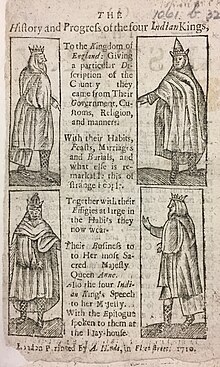


The Four Indian Kings or Four Kings of the New World were three Mohawk chiefs from one of the Five Nations of the Iroquois Confederacy and a Mohican of the Algonquian peoples, whose portraits were painted by John Verelst in London to commemorate their travel from New York in 1710 to meet Queen Anne of Great Britain.[1] The three Mohawk were: Sa Ga Yeath Qua Pieth Tow of the Bear Clan, called King of Maquas, with the Christian name Peter Brant (grandfather of Mohawk leader Joseph Brant); Ho Nee Yeath Taw No Row of the Wolf Clan, called King of Canajoharie ("Great Boiling Pot"), or John of Canajoharie; and Tee Yee Ho Ga Row, meaning "Double Life", of the Wolf Clan, also called Hendrick Tejonihokarawa or King Hendrick.[2] The Mohican chief was Etow Oh Koam of the Turtle Clan, mistakenly identified in his portrait as Emperor of the Six Nations. The Algonquian-speaking Mohican people were not part of the Iroquois Confederacy. Five chiefs set out on the journey, but one died in mid-Atlantic.[citation needed]
- ^ Oosterom, Nelle. "Kings of the New World". www.canadashistory.ca.
- ^ Cite error: The named reference
snowwas invoked but never defined (see the help page).
